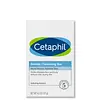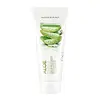What's inside
What's inside
 Benefits
Benefits

 Concerns
Concerns

 Ingredients Side-by-side
Ingredients Side-by-side

Sodium Cocoyl Isethionate
CleansingStearic Acid
CleansingSodium Tallowate
CleansingWater
Skin ConditioningSodium Isethionate
CleansingSodium Cocoate
CleansingSodium Stearate
CleansingGlycerin
HumectantSodium Chloride
MaskingPEG-20
HumectantParfum
MaskingPetrolatum
EmollientSodium Isostearoyl Lactylate
EmulsifyingSucrose Cocoate
EmulsifyingTitanium Dioxide
Cosmetic ColorantPentasodium Pentetate
Tetrasodium Etidronate
Emulsion StabilisingSodium Palm Kernelate
CleansingSodium Cocoyl Isethionate, Stearic Acid, Sodium Tallowate, Water, Sodium Isethionate, Sodium Cocoate, Sodium Stearate, Glycerin, Sodium Chloride, PEG-20, Parfum, Petrolatum, Sodium Isostearoyl Lactylate, Sucrose Cocoate, Titanium Dioxide, Pentasodium Pentetate, Tetrasodium Etidronate, Sodium Palm Kernelate
Water
Skin ConditioningGlycerin
HumectantStearic Acid
CleansingMyristic Acid
CleansingPEG-32
HumectantPotassium Hydroxide
BufferingLauric Acid
CleansingGlyceryl Stearate
EmollientAloe Barbadensis Leaf Juice
Skin ConditioningCananga Odorata Flower Extract
PerfumingLippia Citriodora Leaf Extract
AstringentChamomilla Recutita Flower Water
MaskingHibiscus Sabdariffa Flower Extract
Skin ConditioningJasminum Officinale Flower Water
MaskingLavandula Angustifolia Flower Water
Skin ConditioningMentha Piperita Leaf Water
Skin ConditioningMentha Rotundifolia Leaf Extract
TonicRosmarinus Officinalis Leaf Water
MaskingSalvia Officinalis Leaf Extract
CleansingCocamidopropyl Betaine
CleansingTea-Lauryl Sulfate
CleansingSodium Chloride
MaskingPotassium Cocoyl Glycinate
Laureth-2
CleansingSodium Sulfate
Potassium Cocoate
EmulsifyingButylene Glycol
HumectantEthyl Hexanediol
SolventCitric Acid
BufferingDisodium EDTA
Sodium Benzoate
MaskingPhenoxyethanol
PreservativeParfum
MaskingCI 19140
Cosmetic ColorantCI 42090
Cosmetic ColorantWater, Glycerin, Stearic Acid, Myristic Acid, PEG-32, Potassium Hydroxide, Lauric Acid, Glyceryl Stearate, Aloe Barbadensis Leaf Juice, Cananga Odorata Flower Extract, Lippia Citriodora Leaf Extract, Chamomilla Recutita Flower Water, Hibiscus Sabdariffa Flower Extract, Jasminum Officinale Flower Water, Lavandula Angustifolia Flower Water, Mentha Piperita Leaf Water, Mentha Rotundifolia Leaf Extract, Rosmarinus Officinalis Leaf Water, Salvia Officinalis Leaf Extract, Cocamidopropyl Betaine, Tea-Lauryl Sulfate, Sodium Chloride, Potassium Cocoyl Glycinate, Laureth-2, Sodium Sulfate, Potassium Cocoate, Butylene Glycol, Ethyl Hexanediol, Citric Acid, Disodium EDTA, Sodium Benzoate, Phenoxyethanol, Parfum, CI 19140, CI 42090
Ingredients Explained
These ingredients are found in both products.
Ingredients higher up in an ingredient list are typically present in a larger amount.
Glycerin is already naturally found in your skin. It helps moisturize and protect your skin.
A study from 2016 found glycerin to be more effective as a humectant than AHAs and hyaluronic acid.
As a humectant, it helps the skin stay hydrated by pulling moisture to your skin. The low molecular weight of glycerin allows it to pull moisture into the deeper layers of your skin.
Hydrated skin improves your skin barrier; Your skin barrier helps protect against irritants and bacteria.
Glycerin has also been found to have antimicrobial and antiviral properties. Due to these properties, glycerin is often used in wound and burn treatments.
In cosmetics, glycerin is usually derived from plants such as soybean or palm. However, it can also be sourced from animals, such as tallow or animal fat.
This ingredient is organic, colorless, odorless, and non-toxic.
Glycerin is the name for this ingredient in American English. British English uses Glycerol/Glycerine.
Learn more about GlycerinParfum is a catch-all term for an ingredient or more that is used to give a scent to products.
Also called "fragrance", this ingredient can be a blend of hundreds of chemicals or plant oils. This means every product with "fragrance" or "parfum" in the ingredients list is a different mixture.
For instance, Habanolide is a proprietary trade name for a specific aroma chemical. When used as a fragrance ingredient in cosmetics, most aroma chemicals fall under the broad labeling category of “FRAGRANCE” or “PARFUM” according to EU and US regulations.
The term 'parfum' or 'fragrance' is not regulated in many countries. In many cases, it is up to the brand to define this term.
For instance, many brands choose to label themselves as "fragrance-free" because they are not using synthetic fragrances. However, their products may still contain ingredients such as essential oils that are considered a fragrance by INCI standards.
One example is Calendula flower extract. Calendula is an essential oil that still imparts a scent or 'fragrance'.
Depending on the blend, the ingredients in the mixture can cause allergies and sensitivities on the skin. Some ingredients that are known EU allergens include linalool and citronellol.
Parfum can also be used to mask or cover an unpleasant scent.
The bottom line is: not all fragrances/parfum/ingredients are created equally. If you are worried about fragrances, we recommend taking a closer look at an ingredient. And of course, we always recommend speaking with a professional.
Learn more about ParfumChances are, you eat sodium chloride every day. Sodium Chloride is also known as table salt.
This ingredient has many purposes in skincare: thickener, emulsifier, and exfoliator.
You'll most likely find this ingredient in cleansers where it is used to create a gel-like texture. As an emulsifier, it also prevents ingredients from separating.
There is much debate on whether this ingredient is comedogenic. The short answer - comedogenic ratings don't tell the whole story. Learn more about comegodenic ratings here.
The concensus about this ingredient causing acne seems to be divided. Research is needed to understand if this ingredient does cause acne.
Scrubs may use salt as the primary exfoliating ingredient.
Learn more about Sodium ChlorideStearic Acid is a fatty acid. It is an emollient, emulsifier, and texture enhancer.
As an emollient, stearic acid helps soften skin. It aids the skin's protective barrier by preventing water loss. It also provides a gentle cleansing effect without stripping away natural oils.
Stearic acid may also be used to enhance the texture of products. It can add volume and stabilize ingredients such as water and oil. This can help water and oil ingredients from separating.
Sources of stearic acid include animal or vegetable fats/oils such as coconut or shea. It can be naturally found in butter, cocoa butter, shea butter, vegetable fats, and animal tallow.
This ingredient may not be Malassezia folliculitis, or fungal-acne safe.
Learn more about Stearic AcidWater. It's the most common cosmetic ingredient of all. You'll usually see it at the top of ingredient lists, meaning that it makes up the largest part of the product.
So why is it so popular? Water most often acts as a solvent - this means that it helps dissolve other ingredients into the formulation.
You'll also recognize water as that liquid we all need to stay alive. If you see this, drink a glass of water. Stay hydrated!
Learn more about Water